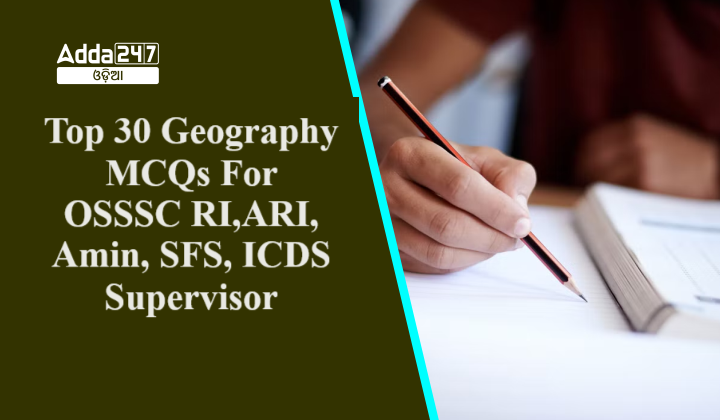Geography is a crucial subject for various competitive exams in India, including those conducted by the Odisha Subordinate Staff Selection Commission (OSSSC) for the positions of Revenue Inspector (RI), Assistant Revenue Inspector (ARI), Amin, Senior Field Surveyor (SFS), and ICDS Supervisor. To aid aspirants in their preparation, here are the top 30 multiple-choice questions (MCQs) covering various aspects of Indian Geography:
Top 30 Geography MCQs For OSSSC RI,ARI, Amin, SFS, ICDS Supervisor
- Cyclones are called as hurricanes in:
A. Bangladesh
B. China
C. Gulf of Mexico and Caribbean Sea
D. Japan
Answer: C. Gulf of Mexico and Caribbean Sea
Discussion: Hurricanes are specific to the North Atlantic, Gulf of Mexico, and Caribbean Sea regions, whereas similar systems in the Northwest Pacific are called typhoons, and in the South Pacific and Indian Ocean, they are called cyclones. - Which among the following forms of precipitation is different from the rest?
A. Dew
B. Fog
C. Mist
D. Hail
Answer: D. Hail
Discussion: Hail is solid precipitation in the form of balls or lumps of ice, while dew, fog, and mist are forms of liquid precipitation or condensation. - The Savannas or Orinoco Basin are termed as:
A. Pampas
B. Steppes
C. Prairies
D. Llanos
Answer: D. Llanos
Discussion: Llanos refers to the vast tropical grassland plain situated to the east of the Andes in Colombia and Venezuela. - Which among the following countries lies at the junction of three continents (Asia, Africa, and Europe)?
A. Turkey
B. Cyprus
C. Syria
D. Yemen
Answer: B. Cyprus
Discussion: Cyprus is geographically positioned at the intersection of Europe, Asia, and Africa, although it is politically and culturally closer to Europe. - Trincomalee is a port situated on the:
A. East coast, Tamil Nadu
B. East coast of Sri Lanka
C. East coast, Andhra Pradesh
D. West coast of Sri Lanka
Answer: B. East coast of Sri Lanka
Discussion: Trincomalee is a natural harbor and port city on the northeastern coast of Sri Lanka. - Borobudur in Java is famous for:
A. Lord Buddha’s tooth preserved for posterity
B. A Buddhist Temple
C. Its natural museum
D. Fisheries Research Station
Answer: B. A Buddhist Temple
Discussion: Borobudur is a 9th-century Mahayana Buddhist temple in Central Java, Indonesia, and is a UNESCO World Heritage site. - Shwedagon pagoda is located in:
A. Mahabalipuram
B. Rangoon
C. Mandalay
D. Jakarta
Answer: B. Rangoon
Discussion: The Shwedagon Pagoda is a prominent stupa located in Yangon (formerly Rangoon), Myanmar. - Which of the following countries has got its map on its flag?
A. Congo
B. Cyprus
C. Jordan
D. Libya
Answer: B. Cyprus
Discussion: The flag of Cyprus features a map of the island above two olive branches. - The Earth’s axis is tilted at an angle of ____ degrees from the perpendicular to its orbital plane.
A. 17.5°
B. 23.5°
C. 36°
D. 45°
Answer: B. 23.5°
Discussion: The Earth’s axis is tilted at approximately 23.5 degrees relative to its orbital plane around the Sun, causing the seasons. - The first oil well in the world was drilled at:
A. Assam
B. Japan
C. Pennsylvania
D. Former USSR
Answer: C. Pennsylvania
Discussion: The first commercial oil well was drilled by Edwin Drake in Titusville, Pennsylvania, in 1859. - The most valuable cash crop of Brazil is:
A. Tea
B. Coffee
C. Cardamom
D. Spices
Answer: B. Coffee
Discussion: Brazil is one of the largest producers of coffee in the world. - Pearl Harbour, the target of the Japanese attack on the American fleet, is in:
A. Japan
B. Philippines
C. Hawaiian Islands
D. Singapore
Answer: C. Hawaiian Islands
Discussion: Pearl Harbor is a lagoon harbor on the island of Oahu, Hawaii, west of Honolulu. - ‘Abadan’ is well known as:
A. A major Air Force base in Iraq
B. The main oil terminal in Iran
C. A pilgrim center for Muslims and Christians as well
D. An archaeological site throwing new light on the civilization that flourished in Arabia before the advent of Aryans into India
Answer: B. The main oil terminal in Iran
Discussion: Abadan is a city in Iran known for its oil refinery, one of the largest in the world. - ‘Roaring Forties’ are:
A. Waterfalls in Canada
B. Cyclonic winds
C. The turbulent years in world history from 1940 to 1944
D. Westerly winds blowing throughout the year over the oceans of the Southern Hemisphere between 40° and 60° South
Answer: D. Westerly winds blowing throughout the year over the oceans of the Southern Hemisphere between 40° and 60° South
Discussion: The Roaring Forties are strong westerly winds found in the Southern Hemisphere between the latitudes of 40° and 60°. - Tokyo, the capital of Japan, is situated in the island of:
A. Hokkaido
B. Honshu
C. Shikoku
D. Kyushu
Answer: B. Honshu
Discussion: Tokyo is located on the island of Honshu, the largest of Japan’s islands. - “Haneda” is the name of the international airport in:
A. Hong Kong
B. Dhaka
C. Tokyo
D. Singapore
Answer: C. Tokyo
Discussion: Haneda Airport, also known as Tokyo International Airport, is one of the primary airports serving Tokyo, Japan. - The river Mahaweli flows through:
A. India
B. Bangladesh
C. Sri Lanka
D. Pakistan
Answer: C. Sri Lanka
Discussion: The Mahaweli River is the longest river in Sri Lanka. - Which among the following countries occupies the largest chunk of the Sunderban’s Delta?
A. Bangladesh
B. Myanmar
C. India
D. Thailand
Answer: A. Bangladesh
Discussion: The Sundarbans delta spans both India and Bangladesh, but a larger portion of it lies within Bangladesh. - Japan’s total land is about _____ that of India.
A. One-sixth
B. One-fifth
C. One-ninth
D. One-tenth
Answer: C. One-ninth
Discussion: Japan’s land area is approximately one-ninth the size of India’s land area. - Which among the following statements about the earth is not true?
A. The Earth makes one complete revolution round the Sun every 365 days, 5 hours, 48 minutes, and 46 seconds
B. The Earth makes one complete revolution on its axis in 48 hours
C. The Earth revolves in its orbit round the Sun at a speed of 66,000 miles per hour
D. The Earth rotates on its axis at an equatorial speed of more than 1000 miles per hour
Answer: B. The Earth makes one complete revolution on its axis in 48 hours
Discussion: The Earth makes one complete rotation on its axis approximately every 24 hours, not 48 hours. - Mount Kilimanjaro is in:
A. Alaska
B. Argentina
C. Chile
D. Tanzania
Answer: D. Tanzania
Discussion: Mount Kilimanjaro is the highest mountain in Africa, located in Tanzania. - Mount Kailas is in:
A. Nepal
B. Tibet
C. Sikkim
D. Bhutan
Answer: B. Tibet
Discussion: Mount Kailas, a sacred peak in several religions, is located in Tibet. - Venus has an atmosphere made up of:
A. Ammonia
B. Carbon dioxide
C. Helium
D. Hydrogen
Answer: B. Carbon dioxide
Discussion: Venus has a dense atmosphere composed mainly of carbon dioxide, with clouds of sulfuric acid.The dwarf camels, - The dwarf camels, known as Alpacas, Vicunas, and Llamas are found in:
A. Tibet
B. Afghanistan
C. Myanmar
D. Cyprus
Answer: A. Tibet
Discussion: These animals are native to the Andean regions of South America, primarily in Peru, Bolivia, Ecuador, and northern Chile, but Tibet is also known for its similar high-altitude animals. - The difference between the diameter of the Earth at the poles and at the equator is:
A. 27 miles
B. 36 miles
C. 48 miles
D. 57 miles
Answer: A. 27 miles - Madagascar is the only home of many species of:
A. Giraffe
B. Hippopotamus
C. Lemur
D. Orangutan
Answer: C. Lemur
Discussion: Lemurs are native to Madagascar and are not found naturally anywhere else in the world. - A heavenly body which takes nearly the same time to complete one rotation and one revolution is:
A. An asteroid
B. A comet
C. Moon
D. Mars
Answer: C. Moon
Discussion: The Moon takes about the same time to complete one rotation on its axis as it does to orbit the Earth, resulting in the same side always facing Earth (synchronous rotation). - “Limnology” refers to the study of:
A. Limestone
B. Lignite or brown coal
C. Lakes and ponds
D. Laterites
Answer: C. Lakes and ponds
Discussion: Limnology is the scientific study of inland waters, specifically lakes and ponds. - A geographical mile is a measure of length equal to one-sixtieth of a degree or one minute (1′) of latitude. It varies with latitudes, but is approximately equal to:
A. 7200 feet
B. 6080 feet
C. 4500 feet
D. 6000 feet
Answer: B. 6080 feet
Discussion: A geographical mile is approximately 6080 feet. - Which of the following planets:
A. Mars
B. Saturn
C. Uranus
D. Venus
Answer: D. Venus









